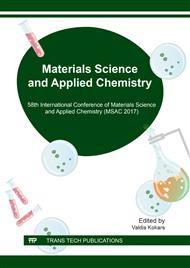[1]
O. Rzayev, D. Erdönmez, K. Erkan, M. Şimşek, U. Bunyatova, Functional Copolymer/Organo-MMT Nanoarchitectures. XXII. Fabrication and Characterization of Antifungal and Antibacterial Poly (Vinyl Alcohol-co-Vinyl Acetate/ODA-MMT/AgNPs Nanofibers and Nanocoatings by e-Spinning and c-Spinning Methods, International Journal of Polymeric Materials and Polymeric Biomaterials, 64 (2015).
DOI: 10.1080/00914037.2014.936599
Google Scholar
[2]
J. Markarian, Automotive and packaging offer growth opportunities for nanocomposites. Plast. Addit. Compound. (2005) 18-25 (November/December).
Google Scholar
[3]
J. Kostjukovs, A. Actiņš, J. Karasa, EU patent apl. Nr. EP 2690067 A1.
Google Scholar
[4]
Directive 98/8/EC of the European parlament concerning the placing of biocidal products on the market, Official Journal of the European Communities (1998).
Google Scholar
[5]
L. Guilhermino, T. Diamantino, M. C. Silva, A. M. V. M. Soares, Acute Toxicity Test with Daphnia magna: An Alternative to Mammals in the Prescreening of Chemical Toxicity?, Ecotoxicology and Environmental Safety 46 (2000) 357-362.
DOI: 10.1006/eesa.2000.1916
Google Scholar
[6]
X. Li, B.J. Brownawell, Analysis of quaternary ammonium compounds in estuarine sediments by LC-ToF-MS: very high positive mass defects of alkylamine ions as powerful diagnostic tools for identification and structural elucidation, Anal. Chem. 81 (2009).
DOI: 10.1021/ac900900y
Google Scholar
[7]
VSIA Latvian Standards EN ISO 6341: 2013, Water quality-determination of the inhibition of the mobility of Daphnia magna Straus (Cladocera, Crustacea)-acute toxicity test, Riga, (2013).
DOI: 10.3403/30213505
Google Scholar
[8]
Klüttgen B, Dülmer U, Engels M, Ratte HT, ADaM, an artificial freshwater for the culture of zooplankton. Water Res. 28 (1994) 743-746.
DOI: 10.1016/0043-1354(94)90157-0
Google Scholar
[9]
C. Zhang; C. Fang; G. Zeng, M. Jiang, Z. Yang, Z. Yu, M. Zhu, L. Shen, Quaternary ammonium compounds (QACs): A review on occurrence, fate and toxicity in the environment, Sci. Total Env. (2015) 352-362.
DOI: 10.1016/j.scitotenv.2015.03.007
Google Scholar


